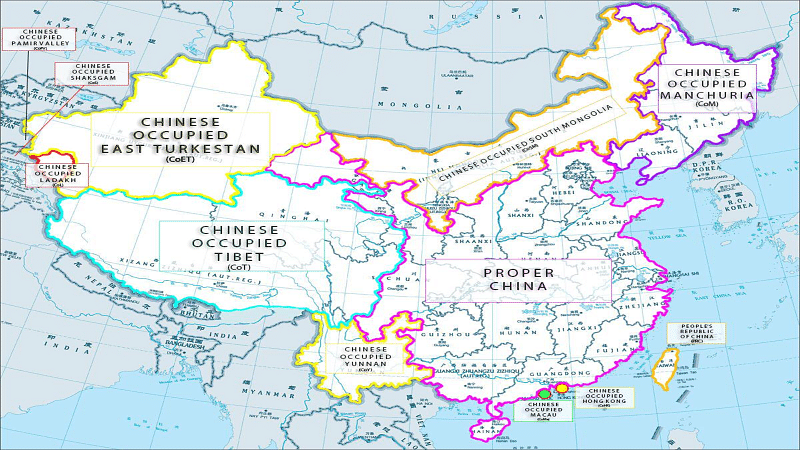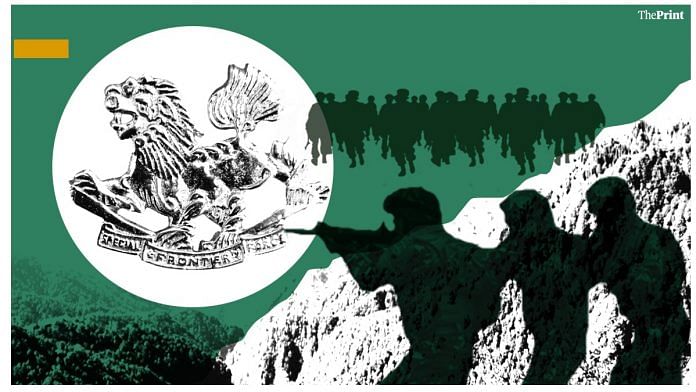The move by the Indian Army on the night of 31 August to occupy prominent hill tops south of the Pangong Tso in Ladakh is a positive sign. It indicates India’s readiness to take an offensive action against China in the ongoing stand-off along the Line of Actual Control. But few, including Army personnel, know about the force that was behind this crucial operation — the Special Frontier Force, or SFF.
Formed on 14 November 1962, the SFF or Establishment 22 (‘two-two’) is the Army’s most secret guerrilla force. They are trained as high-altitude paratroopers, commandos, well versed in the arts of ambush, demolition, survival and sabotage. Very little is known about their presence and activities. They function under the intelligence agency Research and Analysis Wing (R&AW) and report directly to the Prime Minister’s Office (PMO) via the Directorate General of Security in the Cabinet Secretariat. The Indian government denies the existence of this force, which supposedly comprises exiled Tibetan youth who had fled to India along with the Dalai Lama.
Little-known force
The SFF was formed initially to conduct covert operations behind the Chinese lines in the event of a war. Its main assigned task was reportedly to infiltrate as guerrillas and destroy Chinese lines and communication; damage roads, airfields and radar installations; compel the Chinese to deploy disproportionate force at rear security; and create insurgency and rebellion in Tibet, which would in turn help the Indian Army in engaging the Chinese at the border.
The SFF participated with exemplary skill in Operation Eagle (securing the Chittagong hills in the 1971 war), Operation Blue Star (clearing the Golden Temple in 1984), Operation Meghdoot (securing the Siachen glacier in 1984) and Operation Vijay (at Kargil in 1999). The phantoms who initially joined to fight for a free Tibet, are now fighting someone else’s battle — not with any mercenary greed but with gratitude for India.
Committing the SFF for the mission in Ladakh and acknowledging their presence appears to be the first step towards challenging China’s grip by using the Tibetan population. If China has to fight India in eastern Ladakh, it has to be from Tibetan land. Can this be an opportunity to cultivate more of the local Tibetan population to fight for the Indian cause, which will in turn help their cause of achieving an independent Tibet? The action of the SFF in eastern Ladakh must have influenced quite a few youth from the Tibet region. We need to use this force in our fight against China.
Also read: Army thwarting PLA on Pangong Tso south bank is a warning that India is ‘fighting fit’
Building on the Galwan confidence
Let’s extend this theory to the ASEAN group of countries, especially those that are affected by China’s expansionist policy. A look at China’s map shows that it has border disputes not only with India but with 17 other countries. The map clearly indicates that it has annexed almost the same area of land it originally possessed. To establish its claim on the land of other countries such as Mongolia, Laos, Tajikistan, Cambodia, North Korea, and Vietnam, China uses ‘historic precedence’. With countries such as Japan, India, Nepal, Philippines, Russia, Singapore, South Korea, Bhutan, Taiwan, Brunei, Indonesia, and Malaysia, it is just a unilateral claim by China.
A study of territorial disputes of these 18 countries with China will substantiate my claim of their likely readiness to join hands with India to resist Beijing’s expansionist policy.

The enemy of my enemy is my friend — is an ancient proverb that suggests that two parties can or should work together against a common enemy. China has already annexed many square kilometres of land from all these nations and is unilaterally claiming much more. Therefore, all these nations are well aware of the fact that the current stand-off with India in Ladakh can be replicated in their lands in future.
With the newfound confidence post Galwan clashes, India should be taking the lead in the fight against an expansionist China. First, we need to befriend these countries by indulging with them in trade, cultural exchanges and few confidence-building measures. What we have lost in terms of trade due to the ban on some Chinese products can be gained from these countries. Japan, South Korea, Vietnam, Singapore, Taiwan and the Philippines can be the main contenders for bilateral trade. Once these relations are established, it will be easier to move ahead in the field of military exchanges. If India and these 17 countries together decide to resist the expansionist policy of China, then Beijing’s military strength will get badly divided in trying to put down the resistance.
Also read: Sumdorong Chu, Ladakh-like India-China face-off which took 9 yrs to end but without violence
India’s route to allies
Befriending Tibet can be the starting point. Many nations can then be brought about on a common platform using the ASEAN forum. Most of these countries will accept India to lead them in this struggle due to the role New Delhi plays in Asia and, more importantly, because of its belief in the democratic process for governance. Moreover, the way India has handled the current crisis with China will give confidence to these nations about their capabilities and ability to challenge China, if needed.
To find able partners in its fight against China’s expansionist policies, India has stitched a pact with the US, Australia, and Japan — known as the Quad — to protect its sea route. Even the US is promising to help India in any crisis with China. Given the trade relations between the US and China, should India trust America? China is our neighbour and expecting Western countries to help us in our hour of need is far-fetched. Also, considering our long-standing relations with Russia and our dependence on them for military hardware, will it be right to get cosier with the US?
India may have the will and courage to fight, but do we have the financial backing to sustain a long-drawn war? In such a scenario, taking help from our Asian friends is the right approach. Whether or not the Narendra Modi government is thinking about this possibility (alliance with Asian countries) is a million-dollar question, but the use of SFF in eastern Ladakh definitely points in this direction. Extending it to include other Asian countries needs to be considered as a logical step. We share a common enemy, but does that automatically make us friends? The answer may be in the negative but in these difficult times, it’s better to extend the hand of friendship to achieve a common aim — loosening the China grip.
AVM Suryakant Chafekar, AVSM, Shaurya Chakra, retired as SAASO maintenance command from the Indian Air Force in 2017. Views are personal.







Stop behaving like a rasgolla Or be eaten like one
Russia will not help India in a conflict with China beyond selling cheap but second-rate weapons, until the Chinese tell them to stop.
To receive support, India has to make a commitment, stop sitting on the fence and move towards the US and US allies politically as well as economically.
‘Very little is known about their presence and activities. ‘
But the author knows everything !
After the recent beating from China, the Hindus even said nothing happened. They went quiet for sometime. Now, they have plucked up the courage – to write vain cock and bull stories about their prowess against China, to build on ‘the confidence gained in Galwan’ ! None of this can be tested. We shall only know when China decides to give the next beating.
To be very honest, there is little India can do despite Hindu pretensions of super power status. China clearly did not believe India was a superpower. With an economy 1/5 th the size, which is dashed, and Hindu incompetents ruling and stoking divisions, how is India going to incite Tibetans ? The Hindus have created divisions not only in Kashmir but all over India, so China can also finance them. India has more divisions due to casteism and communalism.
It looks like that either you are a Pakistani or a Muslim from India; who is bent on belittling India.
The diplomatic route is always better than war which harms the citizens and the economy.
China will learn this to their cost like the USA has done by warring all over the world.
China has shown it’s stupidity and base nature by quarrelling with good neighbours like India and aligning itself with Islamic fundamentalists like the Pak army.
China who was riding high economically will pay the price for their belligerence.
While I agree with you that rasgollais another animal from Mecca, India has been a walk over!! Yet!! What has diplomacy given to India for the last 70 years while China has encroached on tens of thousand miles of Indian land through congress and now the same seems to be happening under a nationalist government. What’s the point of diplomacy when your adversary diplomacy to make agreements they break and then rape you again??!!
rasgolla: You & your community deserve Xinjiang, not just in China but in India too!! The boot lickers from Mecca are always ready to be screwed at will along with their pedophile they call god!!
ASIAN Countries Must Join Hands With India To Fight Against China As They Are Not Capable To Do So On Their Own. So, It Is In Their Own National Interest To Come On A Common Platform. An Enemy’s Enemy Should Be Treated As A Friend.
Sir AVM Suryakant Chafekar, it would have been better if you also throw some light on territories occupied illegally by india .
So according to the author, Indian Muslims, dalits, Christians and other minorities should fight against RSS Modi government and India and support Indian Enemies. And that is justified too. Dumb logic
When it’s such a secret force then why is The Print publicising it against the interest of the Nation. Why is The Print exposing our own countries secret to our nations detriment. Can anyone stoop lower than this for its commercial profits ?
had it been a top secret force,nobody would know the details & bring it to public domain….this is very simple
JMehta: WHY do you forget that India has a tonne of traitors paid for China/Pakistan & Vatican??!! These traitors and their media is allowed to operate in India is a bigger surprise!!
Author’s general point about cooperation with other nations bordering CHina is worth following seriously. But let us not imagine that we have gained ascendancy with last week’s operations. That will be verified only after CHina starts a general withdrawal from th e various sectors where thay have occupied Indian territory. That could even take years as earlier examples show.
“But few, including Army personnel, know about the force that was behind this crucial operation — the Special Frontier Force, or SFF.”
Such sensitive defense related military information is not shared by smart nations so publicly.
No one fights for any one else battles………….that is verdict of History………..until 1.4 million Indian army does not revenge the 20 brave dead Indian soldiers………..no Asean or Tibetian is going to fight PLA !!!
Hindus think Americans will fight and die on their behalf.